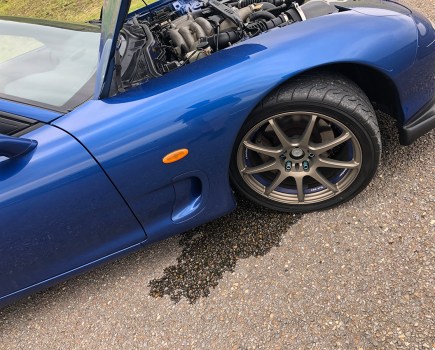Never underestimate the importance of a good wheel alignment setup. It may seem simple, but it has a huge effect on any car’s handling abilities. Here’s our guide to understanding why and how it can improve your car’s performance.
Wheel alignment is crucial to any car, not just modified cars with aftermarket wheels. As such, it doesn’t always receive the care and attention it deserves. You could have best car suspension on the market, with bad alignment comes bad handling.
Let’s look at it in simple terms: your tires are the only contact point between the car and the road. The grip they have with the road is the only thing that allows the car to turn, accelerate or brake. That’s why you should never skimp on fitting decent tires to any car, let alone a performance or tuned one.
As such, optimizing the way those tires interact with the road is, unsurprisingly, a key area to getting the best possible performance out of your car.
Camber, Toe and Caster
There are three main areas you can adjust to tune the tire alignment: camber, toe and caster. Most of these parameters are adjustable even on a standard car, but start adding some upgraded hardware such as fancy coilovers with adjustable top-mounts, camber bolts and adjustable control arms, and you can really tweak things to find the optimum settings for you and your car.
To accurately measure any of these, though, you’ll need either a laser alignment rig or to use the string and plum line method, known affectionately by some as a ‘square-square’.
The square-square method is most accessible to DIY driveway mechanics as it only requires a good length of string, some axle stands and a long, straight tube or bar. Based on creating a perfectly square box around your car, it then accurately measuring distances between wheels and the box. This may sound a bit amateurish but it’s a method preferred by many race teams – it’s a lot easier to carry some tube and string to a race meeting than a full laser alignment rig.
Whichever apparatus you use to measure things, you’ll be making the same adjustments to the same components. So, let’s take a closer look at what those components are and how they affect the car’s handling.
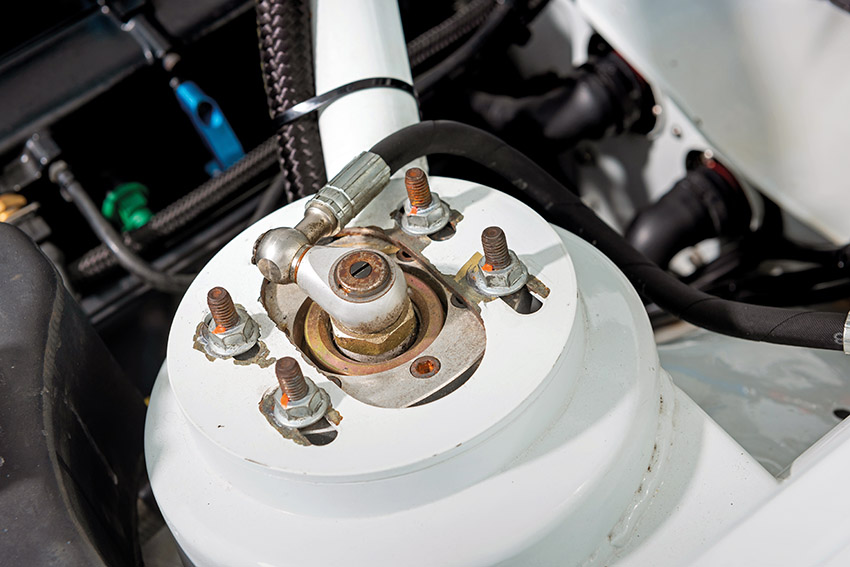
Wheel Alignment | Camber
What is Camber?
Camber is the angle of the wheel on the vertical plane. Neutral camber is when the wheel is dead vertical. If the top of the wheel and tire leans in towards the body of the car, you have negative camber. If the top leans out away from the car, that’s positive camber.
Camber has become a big thing on the ‘stance’ scene in recent years, as it can be helpful when you’re running incredibly low ride heights (and wider wheels) to prevent the wheel rubbing on the wheel arch. But it’s also a key parameter for tuning your car’s handling performance.
How to adjust camber
The easiest way to adjust camber is with adjustable top mounts. These change the position of the top of the strut, adjusting the angle of the hub and wheel assembly. But this can also have the effect of adjusting your caster, which we will come onto later.
Another way, and often used to correct too much negative camber introduced by lowering the car, is to use camber bolts. These are eccentric bolts that allow you to alter the effective fixing point between the hub and damper; simply rotate the bolt to the desired position (most allow up to around +/- 1.5 degrees of camber) and torque up as usual.
For further adjustment you’ll need adjustable control arms. They’re available from various specialists, and will allow you adjust the rear camber without also affecting the toe.
Camber Tuning
When you’re in a corner, the suspension components and body of your car will flex, causing the outside tire to lean outwards and create positive camber. Therefore, to maximize the flat contact patch of the tire during the corner, we tend to start off with an amount of static negative camber, so that as things flex the tire contact patch is at its optimum, to allow you to have the most grip in the corner.
On the front, though, this camber will result in a smaller contact patch when not turning, reducing the amount of straight-line traction the car will have; you’d expect to see drag cars to be camber neutral. As such, front axle camber is a balancing act of traction and braking against cornering.
It’s a similar story on the back. With most modern fast Fords, for example, being front-wheel drive it’s usually just finding the balance between braking and cornering. And with the rear doing less braking than the front, it’s not uncommon to see more camber on the rear axle.
Although it will depend a lot on your car and the circuit/road you are driving on, a good method to check you’re running the right camber is to measure your tire temperatures after a track session: you’re aiming for equal temperatures across the entire tire surface. Colder inside means you might want more negative camber; colder outside indicates less negative camber will help.
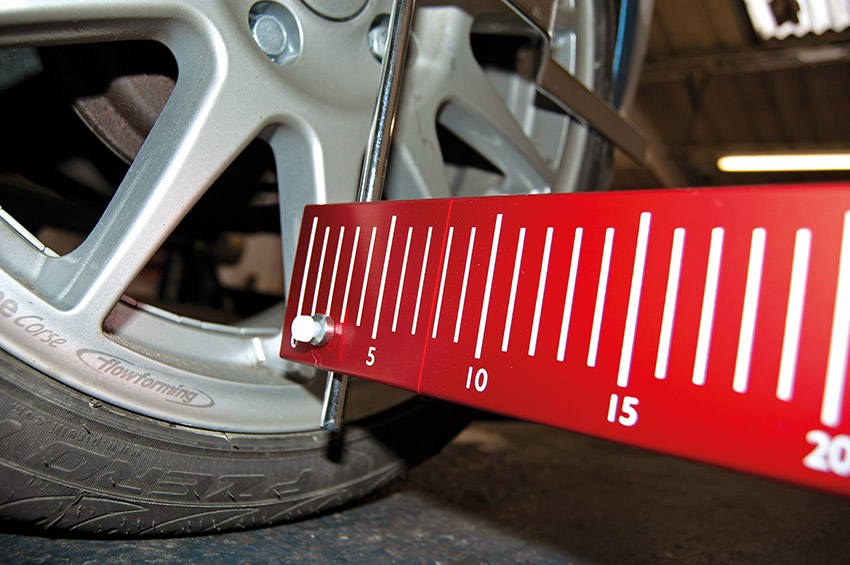
Wheel Alignment | Toe
What is Toe?
Toe is the angle of the wheel on the horizontal plane – in the same direction as steering. If the left- and right-side wheels are both parallel with each other, the toe is neutral. If they slightly point towards each other, that is considered toe-in. The opposite, where the wheels are pointing slightly away from one another, is toe-out.
This is usually measured in angular degrees, but it’s sometimes calculated by the difference in the distances from an imaginary straight line along the side of the car and the front and rear edges of the wheel.
How to adjust Toe
Traditionally, the front axle is used to adjust toe, as many older cars don’t have provision for adjusting rear toe. Front toe is usually adjusted by winding the end of the track rod or steering arm in or out to make it longer or shorter. Which way you need to adjust will depend on whether the steering arm attaches to the front or back of the hub. In most cases the steering arm will attach to the back of the hub, behind the wheel centers, therefore winding in (making the arm shorter) will give you increased toe-out, while winding out, or making longer, will increase toe-in.
In cases where the steering arm mounts to the hub ahead of the wheel center (generally, older cars), it’s the opposite: longer for toe-out, shorter for toe-in.
On many modern fast Fords it’s also possible to adjust rear toe. Standard cars have limited adjustment available on the cam bolt joining the lower control arm to the rear beam, and as we have discussed previously, this can also have the side effect of also changing camber. For more precise adjustment, again as with camber, get a set of adjustable arms. These will also allow for independent toe adjustment and camber changes.
Toe Tuning
It’s worth noting that any toe angle other than straight ahead will increase tire wear and cause a drag effect, slowing down the acceleration and top speed of the car. Yet it is normal for cars to run levels of toe even straight out the factory, to aid stability at speed and improve cornering.
On the front axle, toe-in will give you increased straight-line and mid-corner stability, while toe-out will result in a slightly more agile and faster turn-in but at the expense of the straight-line stability.
On the rear axle it is similar with interesting additional side effects: toe-out actually shortens the effective wheelbase, resulting in a car that feels like it has more mid-corner oversteer. Toe-in will have the opposite effect.
Keep an eye out for excessive tire wear or an offset steering wheel as signs you might want to check your toe angles. They should be equal on both sides when the steering wheel is straight.
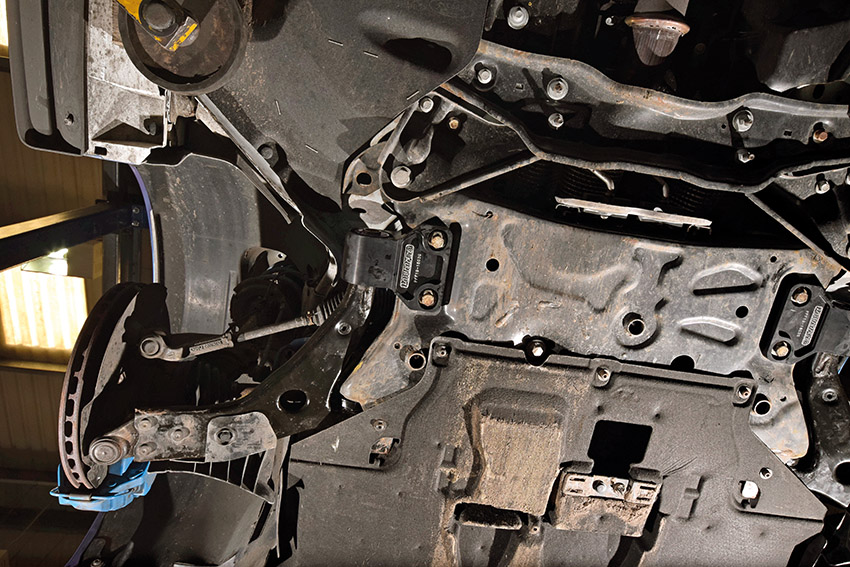
Wheel Alignment | Caster
What is Caster?
Caster is perhaps the most complicated of the three variables when it comes to wheel alignment. The caster angle is the inclination of the axis that the wheel rotates around during steering. As such, it is also a measure of how much camber the wheel gains when turned through steering.
The easiest way to understand caster is to imagine a set of motorcycle forks on the front wheel. The forks are leaning back, and if you were to draw an imaginary line from the forks to the ground it would touch the floor in front of the contact patch of the tire. This is positive caster. If that line was vertical, it would be neutral caster, and if it was to lean forward and have the imaginary line touch the floor behind the wheel, that would be negative caster.
Using the motorcycle analogy again, it would be like riding the bike in reverse, constantly having to hold the steering straight.
It is also worth noting that caster, as a function of the steering, is only relevant for the front axle, unless you have a four-wheel-steer system.
How to adjust Caster
On the MacPherson strut design of suspension found on the front of most hot hatches, the axis that the wheel rotates around during steering is the line drawn from the center of the top mount (where the damper meets the body) and the bottom ball joint (where the lower arm meets the hub).
As such, there are two ways of adjusting the caster: move the top mount or move the ball joint.
There are a handful of top mounts available that allow you to adjust the top of the damper forwards and backwards relative to the body (some coilovers even come with these fitted) and different aftermarket top mounts will have different caster values: for more caster, move the damper rod further backwards.
At the other end, offset bushes are available for the rear mount of the lower wishbone, in order to move that mounting point inwards or outwards relative to the car.
These in turn move the outer ball joint forwards and backwards in the wheel well: for more caster, you want the offset further out from the car.
Similar bushes offer camber adjustment too; an eccentric bolt fixing the wishbone to the chassis allows you to dial in a bit more or less negative camber, by effectively moving the ball joint closer or further away from the car.
Caster Tuning
The main difference you, as a driver, will notice with caster change is steering feel –increased caster results in a heavier but more ‘talkative’ steering. Too much caster will result in steering that is too heavy and makes the car more difficult to drive.
Similarly, this extra wheel-centering force will make the car more stable in a straight line. You may also find that the additional camber brought on by the caster angle in a corner could result in more understeer, as there is less of a contact patch between tire and road. The best solution in this situation is to reduce the amount of negative camber you start off with.
A secondary effect of the added caster is that the outside front wheel will raise up in the wheel well, causing a reduced loading on the inside rear.
This phenomenon, called jacking, can help turn-in and give a more responsive car through oversteer. But if it gets too much, you can reduce your rear roll stiffness with a softer spring rate or softer anti-roll bars.
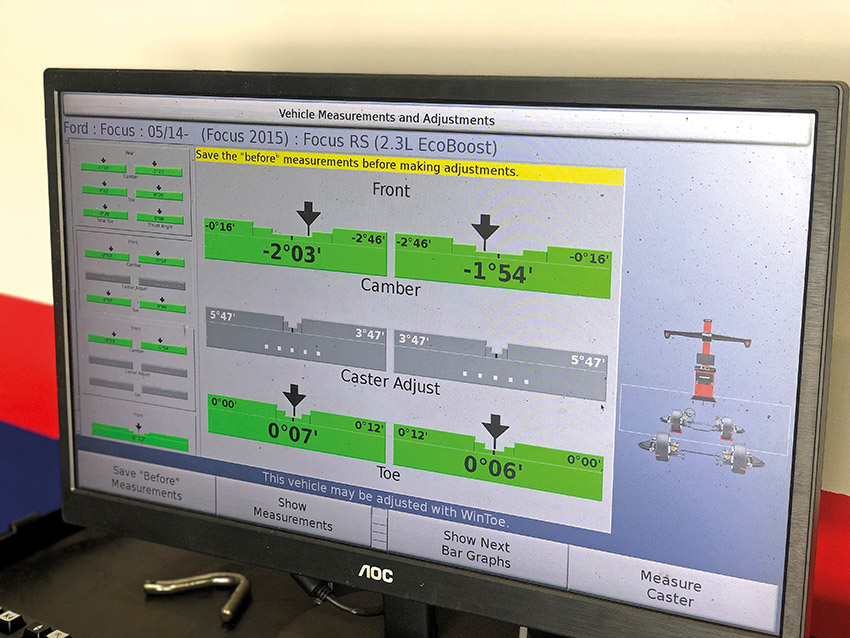
Wheel alignment summary
There are, of course, huge gains to be made from getting your wheel alignment right – both in terms of driver preference and outright performance. But it’s not easy to get right. It’s particularly difficult because it’s all part of a package and changing one area can often affect other areas at the same time. On top of that, the settings are easily knocked out of alignment by a pothole or curb.
As ever, a lot of it is down to the setup on your car and your personal preferences as a driver. Engineers put a lot of time and effort into developing a setup for any car (especially the more sporty models), so the first thing to do is get the wheel alignment set to factory settings as a good base, and then make single adjustments at a time – recording your changes each time for reference – and then figure out what works best for you and your car. There is no magic set of wheel alignment numbers that will work for everyone and every car, so it’s a case of trial and error, making small adjustments at a time until you find the perfect balance.
Guide from Fast Ford magazine. Words: Todd Crooks & Jamie King.




